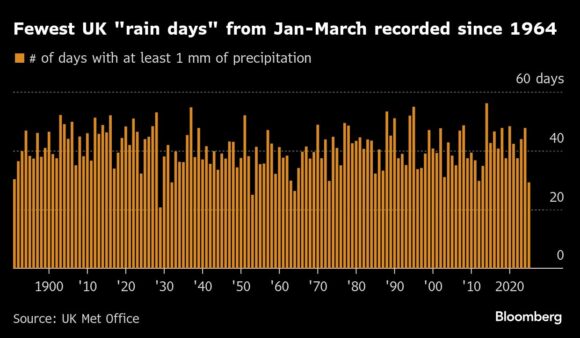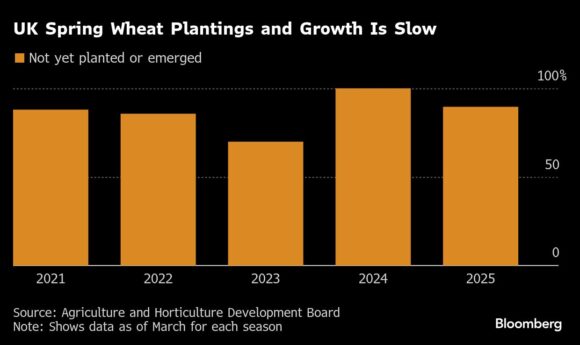The UK’s driest start to the year in four decades is threatening the country’s grain crops and increasing the risk of wildfires.
Total precipitation of about 20.5 centimeters (8.1 inches) during the first quarter was the lowest since 1985, according to Met Office data. Since then, there’s been “little appreciable” rain in the first two weeks of April, according to Lucy Barker, a senior hydrological analyst at the UK Centre for Ecology and Hydrology.
The lack of rain has been compounded by above-average temperatures, leaving farmers anxiously watching weather forecasts. The prolonged dry spell comes after the UK experienced its wettest ever 18 months in the period through March 2024, resulting in record wheat imports for a nation that’s usually close to self-sufficiency.
Europe’s Hottest Year Turbocharged Extreme Weather Across Region
Climate change has seen Europe warm twice as fast as the global average since the 1980s, triggering wild weather swings from wilting heat to the torrential downpours and flooding that hit the region last year. Now, after just three months of 2025, both the UK and Ireland are on track for one of their worst wildfire seasons in decades.

There were just six days of measurable rainfall in March, the fewest in more than 70 years, Met Office figures show.
Spring crops are struggling to germinate in parched fields, said Ben Cooper, a grain and cattle farmer in Wiltshire, England. While winter crops have been able to develop, they need a “solid day or two of steady rain” to make up for the lack of moisture, he added.
About 90% of spring wheat crops were either not yet planted or hadn’t emerged in March, according to Agriculture and Horticulture Development Board data. Following last year’s wash-out, that’s the highest level in the past five seasons.

Farmers across northern and central Europe are facing similar struggles.
A persistent high-pressure weather pattern that’s brought clear skies and a glut of market-disrupting solar generation to parts of the continent has also sapped moisture from an area spanning eastern France to the southern Nordics, as well as parts of Poland and the Baltics, according to a crop monitoring report from the European Commission.
The region received half of the normal rainfall from March through the first half of April, making it among the driest since the early 1990s, the commission found. The conditions helped the region recover from a wet winter, but additional spring rain is “essential” to avoid a drop in crop yields, it said.
Wildfire Threat
The dryness has led to partial droughts in Ireland, while river levels in northern and western parts of the UK are exceptionally low. Average flow in at least five rivers, including the Tyne, Dee and Mourne, dropped to the lowest ever recorded for March, according to the UK Centre for Ecology and Hydrology. At least nine areas in central and southern England saw their driest ever soils.
The conditions are fueling wildfires, with an estimated 121 square miles (313 square kilometers) burnt across the UK so far this year. That’s the most in at least 20 years, according to satellite estimates from the European Forest Fire Information System.
Almost 150 fires have already been recorded across the UK this year, putting the country on track for the highest number of blazes in decades.
It’s unclear how long the dry spell will last.
Parts of Ireland have seen heavy rains in recent weeks, but the country had only received 70% of the norm, according to government forecaster Met Éireann. The story is similar in the UK, which has seen strong local rains, but is still tracking well below long-term averages, according to the Met Office’s Stephen Dixon.
Some wetter and stormier periods are forecast in the weeks ahead, which could revitalize UK crops. But another high-pressure pattern could block the moisture and mean more warm, dry conditions in early May, according to the Met Office.
“It is still very much too early in the season” to know how production will fare, said Millie Askew, AHDB Cereals and Oilseeds lead analyst. “If there was no rainfall up to the end-May, then it may be a different story.”
Photograph: Firefighters tackle a wildfire in Surrey, UK, in 2023. Photo credit: Daniel Leal/AFP/Getty Images
Was this article valuable?
Here are more articles you may enjoy.



 Group Sues California Department of Insurance Over FAIR Plan Surcharges
Group Sues California Department of Insurance Over FAIR Plan Surcharges  Don’t Forget Tariff Impacts on Workers’ Compensation: Berkley
Don’t Forget Tariff Impacts on Workers’ Compensation: Berkley  South Florida Insurance Broker Pleads Guilty to Fraud in $133M ACA Enrollment Scheme
South Florida Insurance Broker Pleads Guilty to Fraud in $133M ACA Enrollment Scheme  Markel Insurance Restructures Markel Specialty, Appoints Leaders
Markel Insurance Restructures Markel Specialty, Appoints Leaders 

